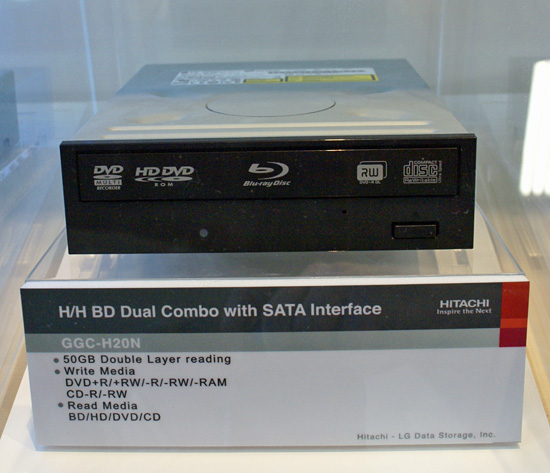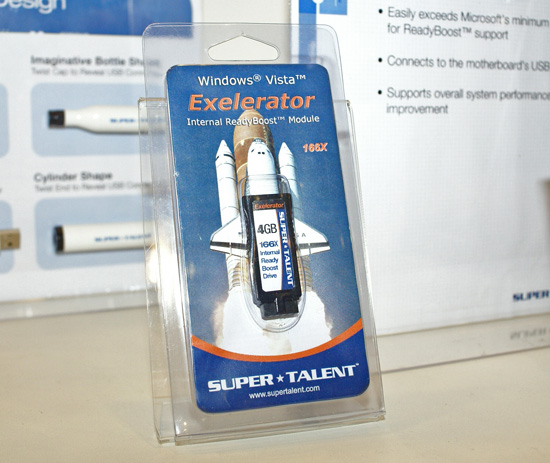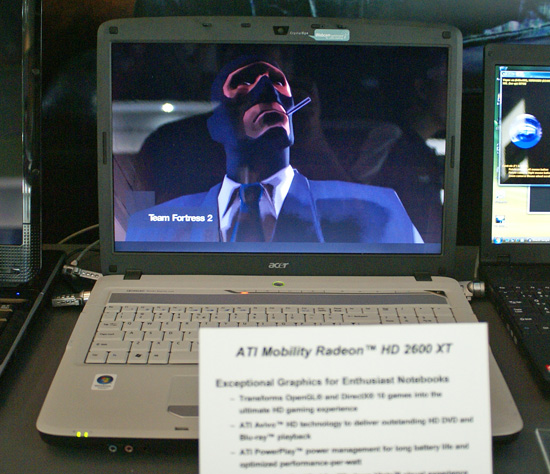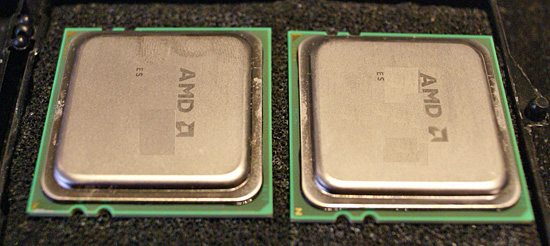Computex 2007: AMD's Barcelona and Other Products
by Gary Key on June 11, 2007 4:00 AM EST- Posted in
- Trade Shows
Hitachi

Hitachi was showcasing several new CinemaStar drives with capacities up to 1TB in the 7k1000 family but we were most interested in their new GGC-H20N optical drive that features DVD/CD writing and Blu-ray, HD-DVD, DVD, and CD read capabilities in a native SATA interface. While it lacks the ability to write to either the Blu-ray or HD-DVD standards, the drive would make for a very good playback device in an HTPC.
Super Talent

Super Talent was displaying several new USB flash drives but one stood out from the rest. Their new Exelerator series is a high speed USB flash drive that comes in capacities up to 4GB, is Windows Vista ReadyBoost approved, and attaches directly to the USB header port on your motherboard thus freeing an additional USB port on the back panel.
AMD


While it wasn't Barcelona, AMD had several product demonstrations with Call of Juarez being shown on several R600 CrossFire Systems in full DX10 glory. Also making an appearance was Team Fortress 2 on several notebooks featuring the ATI HD 2600XT graphics solutions.

Oh yeah, after scouring several computer shops in the greater Taipei area we happened to find a pair of Barcelona chips available. Okay, maybe we broke into an engineering lab and ran off in the middle of the night with them but hey, nobody caught us. (Ed: and you thought all that time playing Ghost Recon was useless....) Once we get proper motherboard/BIOS support, we'll be ready to actually discuss performance.

Hitachi was showcasing several new CinemaStar drives with capacities up to 1TB in the 7k1000 family but we were most interested in their new GGC-H20N optical drive that features DVD/CD writing and Blu-ray, HD-DVD, DVD, and CD read capabilities in a native SATA interface. While it lacks the ability to write to either the Blu-ray or HD-DVD standards, the drive would make for a very good playback device in an HTPC.
Super Talent

Super Talent was displaying several new USB flash drives but one stood out from the rest. Their new Exelerator series is a high speed USB flash drive that comes in capacities up to 4GB, is Windows Vista ReadyBoost approved, and attaches directly to the USB header port on your motherboard thus freeing an additional USB port on the back panel.
AMD


While it wasn't Barcelona, AMD had several product demonstrations with Call of Juarez being shown on several R600 CrossFire Systems in full DX10 glory. Also making an appearance was Team Fortress 2 on several notebooks featuring the ATI HD 2600XT graphics solutions.

Oh yeah, after scouring several computer shops in the greater Taipei area we happened to find a pair of Barcelona chips available. Okay, maybe we broke into an engineering lab and ran off in the middle of the night with them but hey, nobody caught us. (Ed: and you thought all that time playing Ghost Recon was useless....) Once we get proper motherboard/BIOS support, we'll be ready to actually discuss performance.










64 Comments
View All Comments
TA152H - Monday, June 11, 2007 - link
And if they had, they would have probably gone with the memory disambiguation of the Core 2, instead of the non-speculative load reordering of the Pentium Pro to III. They may not have realized when they were making it Intel was going to raise the bar.Either way, it's impossible.
Regs - Monday, June 11, 2007 - link
Sure..maybe they just decided to pick up a plan that was considered dead and go through with it. It was all ready reported they were trying to re-spin the K8 before the Core Duo was ever announced though it was cancelled because it was dependent on highly-threaded applications that are simply not coming any time soon.TA152H - Monday, June 11, 2007 - link
That's a different processor design that they killed. But, you bring up a huge misconception that most non-programmers have, that with more work you can get really great performance out of threading. All you have to do is put in the time and rethink how to code. It's utter nonsense, and there is something called Amdahl's Law that is worth reading for people that don't understand or believe this.Some algorithms will work well with threading, many, many will not. So, yes, AMD killed that dog and luckily so. If they came out with that, I'd be really, really worried for the company.
But this new processor isn't anything particulary risky or scary. It's a very nice upgrade in many areas, and considering the K8 is obsolete, but not horrible like the P7, it should turn out to be a fine processor and at the minimum competitive for a while.
6-12 months is absolutely incorrect. If you're saying that because you believe it, you need to do a little more research on this type of thing because it's entirely implausible. If you're saying it because you're frustrated with AMD and just lashing out, I can understand that completely. But, try to keep it in perspective; it's still a good processor but it just has a few problems before it's release.
Regs - Monday, June 11, 2007 - link
Highly frustrated. If this was a long planned project then their execution is well, I guess we have to see. Like the bias before the Opteron launched I guess we should not make the same mistake twice.TA152H - Monday, June 11, 2007 - link
While I can understand your frustration, try to keep a few things in common.This is pre-release silicon, of course, and that might not seem like such an important thing, but keep in mind that EVERY processor on that core has to run at the designated speed. So, if one can run at 2.8 GHz, one at 2.6 GHz, another at 2.3 GHz, and one at 1.8 GHz, you're stuck at 1.8 GHz for the entire part. The margin for error is so small because of native quad core decision, it's not surprising the numbers are so low considering the stage of development it's in. At this point, the manufacturing is still fairly new, the processor is of course very new, and with the low margin for error it's going to look bad. But, AMD is a weird bird, they seem to come out with terrible processors on the first version of a new lithography, and continue to improve it quite a bit, much moreso than Intel does. This and getting less scatter with regards to maximum frequency should allow the Barcelona to improve pretty quickly through the iterative improvements AMD does with their manufacturing.
I can understand why you'd be frustrated, but I think it's early to give up on them compeletely. I think most of it is the sting of going native quad-core right off the bat with a brand new processor architecture. It's a lot to deal with in one shot, especially with a fairly new manufacturing process. They probably should have done one thing at a time, but sooner or later they'll get it right. I don't think it will be too late for it to matter either, but who knows?
Regs - Monday, June 11, 2007 - link
Yes trust me I read a lot of articles about the "Bark". From its symmetric ALU's, down to the non-speculative memory access reordering.I'm not giving up on AMD at all but it's a ton of fun seeing too CPU manufactures diverge. Just like how you talk about how badly your team is doing mid-season, it some how enlightens your hope for them during the post-season.
TA152H - Tuesday, June 12, 2007 - link
Go Yankees?TowerShield - Monday, June 11, 2007 - link
I was figuring the product might have died after it didn't show up in May.Gary Key - Monday, June 11, 2007 - link
It worked beautifully under XP Pro with my laptop, Vista compatibility still needs some fine tuning before the unit is launched. ASUS is intent on completing the project within the next four to six weeks.poisondeathray - Monday, June 11, 2007 - link
Is the XG Station still designed with the Express Card interface (480Mbit or 2.5Gbit depending on USB or PCI Express)?What impact on high resolution gaming does this limited interface bandwith present?